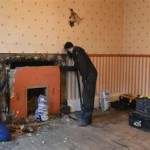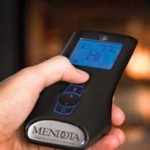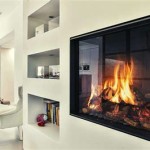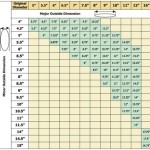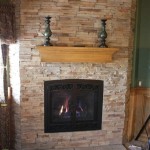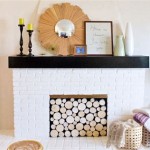Cabin Fireplace Ideas: Creating Warmth and Ambiance in Your Rustic Retreat
A cabin fireplace serves as more than just a source of heat; it stands as a focal point, a gathering place, and a symbol of comfort within the rustic charm of a cabin environment. The selection and design of a cabin fireplace require careful consideration of various factors, including the cabin's architectural style, the desired level of heat output, available space, and personal preferences. This article explores a range of cabin fireplace ideas, providing insights into different types, materials, and design elements that contribute to a warm and inviting atmosphere.
Fireplaces can dramatically affect the aesthetic and functional appeal of a cabin. They not only radiate warmth during cold seasons, but also add a layer of visual interest and cozy ambiance to the living space. From traditional wood-burning models to modern gas or electric options, the variety of choices allows homeowners to tailor the fireplace to suit their specific needs and tastes. Furthermore, the materials used in the fireplace's construction, such as stone, brick, or metal, can reinforce the cabin's overall design theme, whether it leans towards a classic, rustic style or a more contemporary interpretation.
Choosing the Right Type of Fireplace
The first crucial step in selecting a cabin fireplace involves determining the most suitable type, taking into account factors such as efficiency, convenience, and environmental impact. The primary fireplace types include wood-burning, gas, and electric, each possessing unique advantages and disadvantages.
Wood-Burning Fireplaces: These fireplaces represent the traditional choice, offering a genuine and authentic visual experience. The crackling sound of burning wood and the natural aroma contribute a sensory appeal unmatched by other types. However, wood-burning fireplaces require a consistent supply of firewood, regular maintenance (including chimney cleaning), and adherence to safety precautions to prevent fire hazards or carbon monoxide poisoning. Modern wood-burning stoves and inserts offer improved efficiency compared to older open-hearth designs, with features such as airtight construction and catalytic combustors that reduce emissions and increase heat output.
Gas Fireplaces: Gas fireplaces provide a convenient and efficient alternative to wood-burning models. They operate on natural gas or propane, allowing for instant ignition and adjustable flame intensity. Gas fireplaces require professional installation to connect to a gas line and ensure proper venting. While they lack the distinct aroma and crackle of wood, gas fireplaces offer a clean-burning and low-maintenance heating solution. Various styles are available, including traditional log sets, contemporary linear designs, and realistic flame patterns, enabling homeowners to achieve the desired aesthetic appeal.
Electric Fireplaces: Electric fireplaces represent the most convenient and versatile option, requiring only a standard electrical outlet for operation. They produce heat through electric resistance and often feature realistic flame effects created by LED lights and reflective surfaces. Electric fireplaces are ideal for cabins with limited space or where venting is impractical. They offer a safe and clean heating option with adjustable heat settings and remote control operation. While electric fireplaces generally provide supplemental heat, they may not be sufficient for heating larger cabins in extremely cold climates. Their ease of installation and portability make them a popular choice for adding ambiance and supplemental warmth to various areas of the cabin.
Materials and Design Elements for Cabin Fireplaces
The materials used in the construction and design of a cabin fireplace significantly influence its overall aesthetic and impact on the cabin's interior. The choice of materials should complement the cabin's architectural style and reflect the desired ambiance. Common materials include stone, brick, wood, and metal, each offering unique characteristics and design possibilities.
Stone Fireplaces: Stone fireplaces embody a sense of ruggedness and natural beauty, perfectly suited for cabin environments. The use of natural stone, such as river rock, fieldstone, or stacked stone, creates a visually striking focal point that blends seamlessly with the surrounding landscape. Stone fireplaces can be constructed in various shapes and sizes, from simple stacked stone surrounds to elaborate floor-to-ceiling designs with integrated mantels and hearths. The texture and color variations of natural stone add depth and visual interest, contributing to a warm and inviting atmosphere. Stone fireplaces often require professional installation due to the weight and complexity of the materials involved.
Brick Fireplaces: Brick fireplaces offer a classic and timeless appeal, lending a sense of warmth and tradition to cabin interiors. Brick can be used in various patterns and colors, from traditional red brick to painted or distressed finishes, allowing for customization to match the cabin's design theme. Brick fireplaces can be combined with wooden mantels and surrounds to create a cozy and inviting focal point. The durability and heat-retention properties of brick make it a practical choice for wood-burning fireplaces. Brick fireplaces often require professional installation to ensure proper construction and venting.
Wood Fireplace Surrounds: Wood is a prevalent material in cabin construction, and its use in fireplace surrounds enhances the rustic and natural aesthetic. Wooden fireplace surrounds can be crafted from various types of wood, such as reclaimed timber, pine, cedar, or oak, each offering distinct characteristics and visual appeal. Wooden surrounds can be stained, painted, or left natural to showcase the wood's grain and texture. Integrating a wooden mantel provides a functional and decorative space for displaying artwork, photos, or other decorative items. The warmth and natural beauty of wood contribute to a cozy and inviting atmosphere.
Metal Fireplace Accents: Metal accents can add a touch of contemporary elegance or rustic charm to a cabin fireplace. Wrought iron fireplace screens, tool sets, and decorative elements can enhance the fireplace's visual appeal and functionality. Metal can be used in combination with stone, brick, or wood to create a unique and visually striking design. Black metal finishes often complement rustic cabin interiors, while brushed nickel or copper finishes add a touch of sophistication. The durability and versatility of metal make it a practical choice for fireplace accessories and decorative elements.
Integrating Fireplace Design with Cabin Architecture
A well-designed cabin fireplace harmonizes with the cabin's overall architectural style and enhances the sense of place. The fireplace should complement the cabin's layout, scale, and materials, creating a cohesive and inviting atmosphere. Consider the following design considerations when integrating a fireplace into a cabin's architecture:
Scale and Proportion: The size of the fireplace should be proportionate to the size of the room in which it is located. A large fireplace can dominate a small cabin, while a small fireplace may be dwarfed by a large space. Consider the ceiling height, wall dimensions, and overall layout of the room when determining the appropriate size and scale of the fireplace. A well-proportioned fireplace will create a balanced and harmonious focal point.
Placement and Orientation: The placement of the fireplace should maximize its visual impact and functional benefits. A fireplace located on an interior wall can provide warmth to multiple rooms, while a fireplace positioned on an exterior wall can create a focal point visible from both inside and outside the cabin. Consider the orientation of the fireplace in relation to seating areas and windows to optimize views and create a comfortable gathering space. Proper placement can enhance the overall flow and functionality of the cabin's interior.
Integration with Natural Elements: Incorporating natural elements into the fireplace design can enhance the cabin's connection to the surrounding landscape. Using natural stone or wood harvested from the local area can create a sense of place and reinforce the cabin's rustic character. Integrating natural light through windows or skylights near the fireplace can enhance its visual appeal and create a warm and inviting atmosphere. Consider incorporating plants or greenery around the fireplace to soften its edges and add a touch of natural beauty.
Customization and Personalization: A cabin fireplace should reflect the homeowner's personal style and preferences. Consider customizing the fireplace with unique design elements, such as handcrafted mantels, personalized artwork, or family heirlooms. Incorporating personal touches can transform a standard fireplace into a cherished focal point that reflects the cabin's unique character and creates a sense of belonging.
Proper ventilation is critical for any type of fireplace. Wood-burning fireplaces require a properly sized and maintained chimney to safely exhaust combustion byproducts. Gas fireplaces also necessitate venting to prevent the buildup of carbon monoxide. Electric fireplaces do not require venting, making them a more flexible option in certain cabin designs. Regardless of the fireplace type, ensuring proper ventilation is paramount for safety and optimal performance.
Safety considerations are of utmost importance when installing and operating any type of fireplace. All fireplaces should be installed and maintained according to manufacturer instructions and local building codes. Regular chimney inspections and cleaning are essential for wood-burning fireplaces to prevent creosote buildup and chimney fires. Smoke detectors and carbon monoxide detectors should be installed in the cabin to provide early warning of potential hazards. Proper fire safety practices, such as using a fireplace screen and storing firewood safely, can help prevent accidents and ensure a safe and enjoyable fireplace experience.
The selection of a cabin fireplace involves careful consideration of various factors, including the type of fireplace, materials used, design elements, and integration with the cabin's architecture. By carefully considering these factors, homeowners can create a warm, inviting, and visually appealing focal point that enhances the comfort and ambiance of their rustic retreat.

Log Cabin Fireplace S Browse 5 346 Stock Photos Vectors And Adobe

Cabin Fever Hot Fireplace Designs

65 Best Stone Fireplace Design Ideas To Ignite Your Decor Cabin Interior Log

Animal Kingdom Planning A Log Home For Jack Hanna Хижины дома Деревенская хижина Комнатные камины

Log Cabin Fireplaces Your Inspiration Hub

Log Cabin Fireplace S Browse 5 346 Stock Photos Vectors And Adobe

Log Cabin Fireplace Designs Eloghomes

40 Rustic Country Cabins With A Stone Fireplace For Romantic Get Away 39 Log Homes Cabin House

Cabin Fever Hot Fireplace Designs

20 Rustic Stone Fireplace Ideas For Design Inspiration Field Mag
Related Posts

